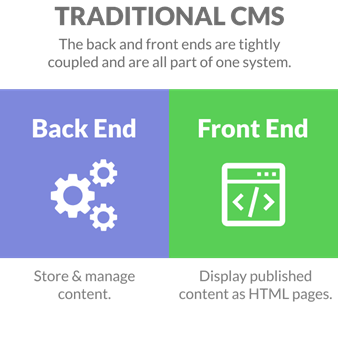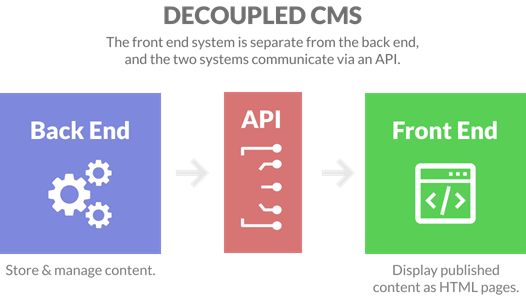

Mar 22, 2021
The content management landscape has been altered considerably over the last few years. While traditional CMS platforms like WordPress and Drupal continue to power many of today’s websites, the influx of new and emerging channels has seen a new type of CMS establish itself.
In major countries throughout the world, there are at least seven connected devices per household, according to Statista.
With consumers demanding content be delivered to mobile devices and tablets, digital kiosks and a host of other smart IoT-embedded devices, the headless CMS has risen to prominence to shoulder the load.
But how does a headless CMS differ from a traditional CMS? What are the benefits for businesses that want to adopt this technology? And what are some of the challenges that they will need to overcome?
We’ll delve into those details and more, but first, a brief overview of how content management systems work and a definition of a headless CMS.
How Content Management Works
In a traditional content management system, both the content management and content delivery aspects of the system are tightly coupled together. What does this mean exactly?
Content management refers to how content is handled on the backend by creators, editors, translators and anyone involved in a content or marketing team. This includes content creation and editing, managing content taxonomy, content versioning, translation, content workflows, security and publishing.
On the other hand, content delivery refers to the content presented to visitors on a website or other channel. This is what end users can see after content has been published.

Headless CMS Explained in 2 Minutes
A headless CMS is a backend-only content management system without a content delivery layer. The “head” that is connected to a website or other front-end channel is removed. Instead, a headless CMS exposes content through APIs in a consumable format to build websites or apps through various front-end frameworks, including .NET, Java, PHP and JavaScript frameworks such as React or Vue.

Unlike a traditional CMS platform that restricts developers to a specific template or method for presenting content, a headless CMS is front-end agnostic, allowing it to serve content to any desired device or channel.
A headless CMS can help you send content to mobile devices, IoT devices, and other platforms using the same API. Whereas legacy CMS platforms such as WordPress and Drupal are ideal for delivering content to websites, the changing landscape of the internet and the content that is consumed means that a headless CMS can provide more flexibility for organizations.
Benefits of a Headless CMS
Headless CMS platforms are becoming increasingly popular, especially in the enterprise landscape, and there are some specific benefits of this type of CMS architecture. Let’s take a look at them.
Decoupled Architecture
Since the front-end delivery and backend content management layers are not tightly coupled together, a headless CMS can provide more flexibility to teams, enabling marketers and developers to work independently. This allows them to make changes to the front-end part of the website or other channel where content is being displayed to users and not worry about affecting the backend.
Front-End Agnostic
Since organizations aren’t limited by the front-end templates and tools of a legacy CMS, they can choose to connect to whichever channel they want and use the frameworks they’re most comfortable with to build digital experiences.
Future-Proof
While many current popular technologies such as smartphones, tablets and even digital kiosks are becoming more commonplace, there is still room for improvement in areas like AR, VR and other emerging technologies. The channels where customers view content can change quite rapidly, but since a headless CMS connects to these channels using APIs, it isn’t affected by such changes.
Headless Commerce
Headless architecture enables content to be used across numerous platforms. A headless platform like Sitecore lets you show the same product details and imagery on mobile, tablet and desktop applications making a headless commerce experience possible.
The headless approach enables richer user experiences for eCommerce through JavaScript frameworks that enhance the front-end UI. Whereas on a traditional or coupled CMS, you’re constrained when it comes to delivering content to different devices and channels. A headless CMS platform can connect these frameworks with your CMS and sync work to deliver content faster.
Omnichannel Customer Journeys
Often an omnichannel customer journey involves customers interacting with a company’s brand through several media channels that seamlessly connect, allowing customers to continue what they were doing on one channel from the next.
For instance, an omnichannel journey might take a user from a social media ad to a brand website. Or from an email newsletter they noticed on a mobile device to a discounted product they purchased on their desktop. With control over the type of content that can be displayed on each channel, digital touchpoints can be connected and businesses get more data about the customer preferences at each step.
Challenges of Using a Headless CMS
While there are several advantages to using a headless CMS, there are some challenging disadvantages that organizations need to consider.
Marketer Restrictions
Headless CMS platforms don’t provide marketers with the templates, WYSIWYG editors and other tools that make their lives easier when it comes to creating and editing content that they might have been used to with a traditional CMS. Instead, they sometimes need to rely on developers to make simple changes to the content on their websites.
Content Previews Disappear
Headless CMSs can deliver content to multiple channels, but many cannot preview content for these channels. As such, content creators may be left scratching their heads and wondering how a particular campaign will look on these alternate channels.
Headless CMS vs Decoupled or Hybrid
While a headless can provide increased freedom and access to a wide array of channels for content delivery with the help of APIs, it can leave marketers struggling to create the content required for these channels.
The answer is a decoupled or hybrid headless CMS. A decoupled CMS carries the same functionality as a headless CMS and provides the templates, preview functionality, and overall marketer-friendly tooling as a traditional CMS. This provides the flexibility to deliver content to new and emerging channels without handicapping the people creating and managing that content.

Oshyn: The Partner In Your Headless Journey
When Audio Digest needed a way to improve the customer experience, they came to Oshyn to help them do it. Oshyn is a Sitecore Partner with extensive experience delivering dynamic customer experiences with the help of marketing technology like a headless CMS.
Implementing a new CMS can be challenging without the right partner. So we integrate ourselves into your team and partner with marketing, user experience, and IT to make sure when you go headless, you don’t lose your head.
Want to learn more about a CMS implementation process? Read our blog on Sitecore Implementation 101.







